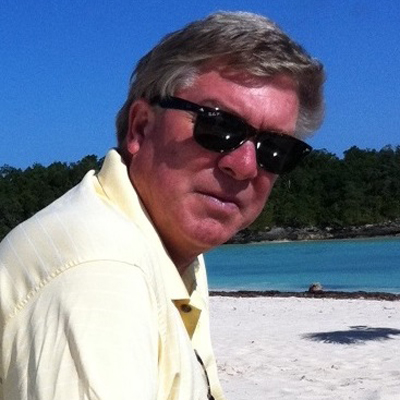
In September 2014, Chris Kenalty suffered a stroke. The stroke team’s quick and efficient code stroke process ensured he had a full recovery. (Photo: Chris Kenalty)
June is Stroke Awareness Month. On June 10, join the Krembil Neuroscience Centre’s Stroke Program in the atrium of Toronto Western Hospital between 10 and 2 to learn about the warning signs of stroke and how to prevent them.
It began as a typical Monday night.
In September 2014, Chris Kenalty and his partner Miriam were in Port Credit, about to sit down for dinner at a Chinese restaurant, when she noticed Kenalty's face was drooping and he had started to drool.
Recognizing that Kenalty, 65, was suffering a stroke, Miriam immediately took him to the nearest hospital.
"I didn't think it was that serious at first," recalled Kenalty. "But I quickly became less and less able to do anything. I thought I could walk but I was losing the use of my legs. I thought I could talk but I was actually just babbling."
Every minute counts
Upon arrival at the hospital, staff confirmed Kenalty was having a stroke. A code stroke was enacted and he was rushed to the nearest stroke centre, in this case, Toronto Western Hospital (TWH).
A stroke centre acts as a "hub" for a specific region and patients having a stroke
are automatically diverted there by emergency medical responders.
The stroke team, having received the alert of a code stroke, was waiting for Kenalty when he arrived in the Emergency Department of TWH. The team members quickly took up their roles to have Kenalty registered, assessed and treated as quickly as possible.
The 'door to needle' time – the phrase used to describe how quickly patients receive treatment after arriving at the hospital – must be as short as possible. Every minute counts to save brain tissue.
Despite the fact that he was suffering a traumatic brain event at the time, Kenalty remembers the process as it unfolded.
"Dr. Leanne Casaubon (neurologist at TWH) was with me from the moment I arrived and everything was happening very swiftly," he said. "With every step of the process, I was met by the corresponding medical team as they worked to treat my stroke and assure me that everything was going to be fine."
Removing the blockage
Scans showed a blockage in a blood vessel in Kenalty's brain. He was administered tissue Plasminogen Activator (tPA) -- the standard treatment to open up the artery. But it was soon evident the tPA wasn't effectively breaking down the blood clot as Kenalty's symptoms weren't improving.
The decision was made to remove the blockage using a clot retrieval procedure called endovascular treatment. At the time, the procedure was being used as part of a clinical trial known as ESCAPE (Endovascular treatment for Small Core and Anterior circulation Proximal occlusion with Emphasis on minimizing CT to recanalization times) to test its effectiveness and has since been established as the standard of care to remove blood clots.
Kenalty, who was not part of the study, was still considered for the procedure because the scans showed the blockage in his brain to be quite large.
"Having this additional intervention for patients has really changed stroke care around the world," says Dr. Robert Willinsky, Interventional Neuroradiologist. "tPA has a roughly 30 per cent success rate, but with the endovascular procedure we have a much greater chance to reverse the damage caused by a stroke."
Now under the care of the interventional neuroradiology team, Kenalty was rushed to the angiography suite. Under image-guided care using an X-ray, Willinsky inserted a thin tube into the artery in Kenalty's groin, threading it through the body, and into the brain arteries to the clot. The clot was then enclosed in a retrievable stent and pulled out, restoring blood flow to the part of the brain that was being damaged.
Throughout the procedure, Kenalty remained awake. He was asked to give his name, date of birth and whereabouts every few minutes to ensure the medical team that other regions of his brain weren't affected by the procedure.
Four days after he'd had his stroke, Kenalty was discharged from TWH. He credits the fast acting and efficient code stroke team for his recovery.
"It's been nine months since my stroke and I feel terrific," Kenalty said.
"My recovery has been so complete that people think I'm joking when I tell them I recently suffered a major stroke."
